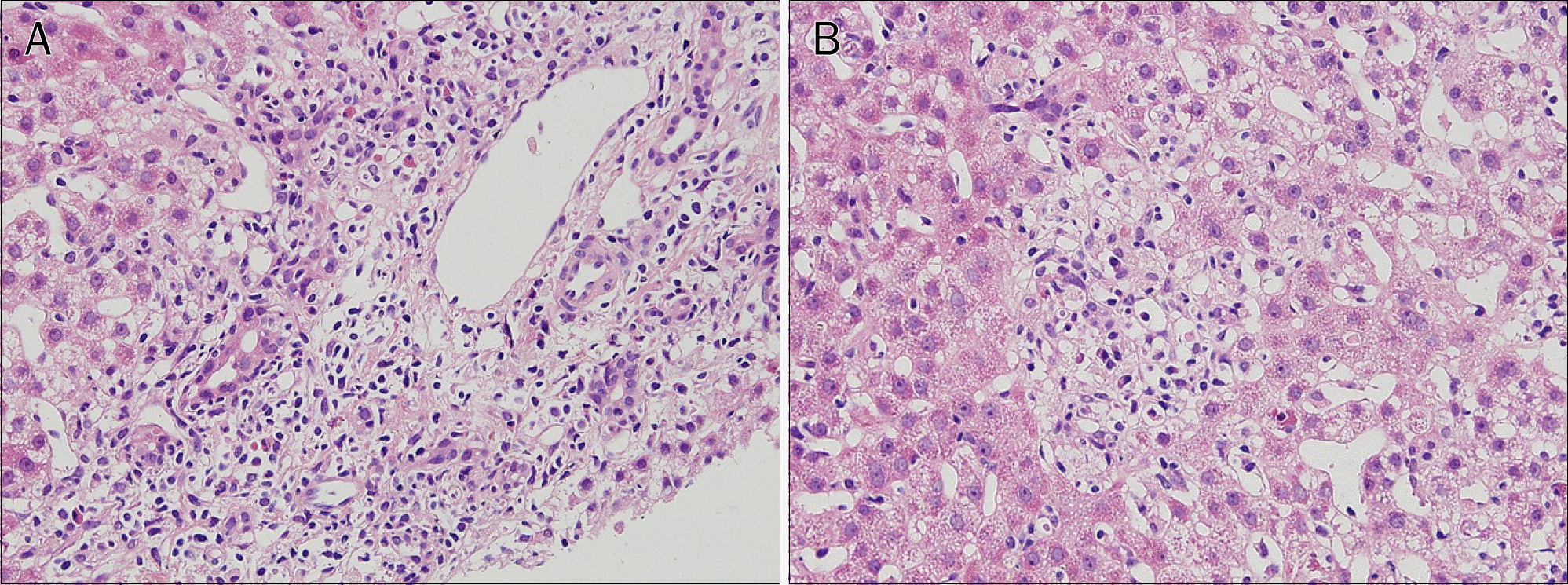Abstract
A 25-year-old woman presented with jaundice, palpitation, and weight loss of 5 kg during a period of 2 weeks. Laboratory tests showed elevated levels of liver enzymes (AST 1,282 IU/L, ALT 1,119 IU/L) and total bilirubin (6.4 mg/dL); negative for hepatitis virus infection; elevated serum levels of triiodothyronine (T3, 3.60 ng/dL), free thyroxine (fT4, 3.82 ng/dL), and lowered serum level of thyroid stimulating hormone (TSH, <0.025 μIU/mL); and positive for thyroid stimulating antibody and anti-mitochondrial antibody (AMA). The liver biopsy findings were consistent with autoimmune hepatitis (AIH). Accordingly, oral steroid therapy was started with 60 mg of prednisolone under the impression of AIH associated with Graves' disease. After a week of steroid therapy, the clinical manifestation showed significant improvement, with normalization of both liver and thyroid functions. Diagnosis of the liver condition of patients who present with hyperthyroidism and liver dysfunction is important, so that appropriate therapy can be promptly initiated.
References
2. Liberal R, Grant CR, Longhi MS, Mieli-Vergani G, Vergani D. Diagnostic criteria of autoimmune hepatitis. Autoimmun Rev. 2014; 13:435–440.

3. Reich DJ, Fiel I, Guarrera JV, et al. Liver transplantation for autoimmune hepatitis. Hepatology. 2000; 32:693–700.

4. Lim KN, Casanova RL, Boyer TD, Bruno CJ. Autoimmune hepatitis in African Americans: presenting features and response to therapy. Am J Gastroenterol. 2001; 96:3390–3394.

5. Czaja AJ, Freese DK. American Association for the Study of Liver Disease. Diagnosis and treatment of autoimmune hepatitis. Hepatology. 2002; 36:479–497.

6. Krawitt EL, Bonis PAL. Treatment of autoimmune hepatitis. Rose BD, editor. UpToDate, version 13.1. Wellesley: UpToDate;2005.
7. Alvarez F, Berg PA, Bianchi FB, et al. International Autoimmune Hepatitis Group Report: review of criteria for diagnosis of autoimmune hepatitis. J Hepatol. 1999; 31:929–938.

8. Johnson PJ, McFarlane IG. Meeting report: International Autoimmune Hepatitis Group. Hepatology. 1993; 18:998–1005.

9. Abe M, Hiasa Y, Masumoto T, et al. Clinical characteristics of autoimmune hepatitis with histological features of acute hepatitis. Hepatol Res. 2001; 21:213–219.

10. Cui B, Abe M, Hidata S, et al. Autoimmune hepatitis associated with Graves' disease. Intern Med. 2003; 42:331–335.

11. Gough A, Chapman S, Wagstaff K, Emery P, Elias E. Minocycline induced autoimmune hepatitis and systemic lupus eryth-ematosus-like syndrome. BMJ. 1996; 312:169–172.

12. Inoue K, Okajima T, Tanaka E, et al. A case of Graves' disease associated with autoimmune hepatitis and mixed connective tissue disease. Endocr J. 1999; 46:173–177.

13. Sato I, Tsunekawa T, Shinohara Y, et al. A case of autoimmune hepatitis with Graves' disease treated by propylthiouracil. Nagoya J Med Sci. 2011; 73:205–209.
14. Duchini A, McHutchison JG, Pockros PJ. LKM-positive autoimmune hepatitis in the western United States: a case series. Am J Gastroenterol. 2000; 95:3238–3241.

15. Hennes EM, Zeniya M, Czaja AJ, et al. International Autoimmune Hepatitis Group. Simplified criteria for the diagnosis of autoimmune hepatitis. Hepatology. 2008; 48:169–176.

17. Onji M, Nonaka T, Horiike N, Moriwaki H, Muto Y, Ohta Y. Present status of autoimmune hepatitis in Japan. Gastroenterol Jpn. 1993; 28(Suppl 4):134–138.

18. Mori T, Akamizu T, Kosugi S, et al. Recent progress in TSH receptor studies with a new concept of “autoimmune TSH receptor disease”. Endocr J. 1994; 41:1–11.

19. Biscoveanu M, Hasinski S. Abnormal results of liver function tests in patients with Graves' disease. Endocr Pract. 2000; 6:367–369.

20. Khemichian S, Fong TL. Hepatic dysfunction in hyperthyroidism. Gastroenterol Hepatol (N Y). 2011; 7:337–339.
Fig. 1.
Histologic findings of liver biopsies are consistent with autoimmune hepatitis (H&E, ×200). (A) Severe necroinflammatory activity with marked portal lymphoplasma cell infiltration with occasional eosinophils and mild ductular proliferation are seen within the portal tract. (B) Local infiltration of inflammatory cells within the lobules and damaged hepatocytes are seen, indicating lobular hepatitis.

Table 1.
Laboratory Data on Admission
Table 2.
Simplified Diagnostic Criteria for AIH15
| Variable | Cutoff a | Points |
|---|---|---|
| ANA or SM | ≥1 : 40 | 1 |
| ANA or SM | ≥1 : 80 | |
| Anti-LKM | ≥1 : 40 | 2 |
| Soluble liver antibody | Positive | |
| IgG | > Upper normal limit | 1 |
| >1.10 times upper normal limit | 2 | |
| Liver histology | Compatible with AIH | 1 |
| Typical AIH | 2 | |
| Absence of viral hepatitis | Yes | 2 |




 PDF
PDF ePub
ePub Citation
Citation Print
Print



 XML Download
XML Download